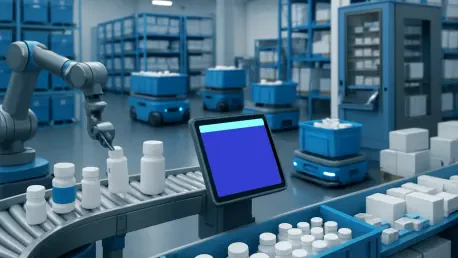Predicting changes in the pharmaceutical supply chain has always involved a certain degree of uncertainty, but current technologies point to several likely transformations and advancements. To navigate these shifts effectively, the supply chain must remain healthy and reliable.
In the coming decade, technologies like blockchain, sensor integration, robotics, automation in warehousing, and advanced planning tools will greatly affect the distribution of medicine. New software can improve the tracking, storage, and delivery of medicinal products, helping the supply chain stay strong during challenges.
This article explores how emerging technologies are set to reshape the pharmaceutical supply chain, highlighting practical applications and benefits for building resilience.
Blockchain Secures the Supply Chain and Ensures Full Visibility
Blockchain technology enables more secure and transparent tracking of pharmaceutical products. It provides a dependable way to track the journey of these products from start to finish, with a clear and permanent record.
During clinical trials, blockchain can help manage the procurement of Investigational Medicinal Products and monitor storage conditions. It can also document transactions and ensure the authenticity of product batches. Consider a global clinical trial in which every item, from vials to blister cards, is assigned a unique identifier, such as a QR code or serial number. Lastly, it is logged in a blockchain ledger, leaving a digital signature that allows for the verification of the product’s authenticity at every stage, from manufacturing to distribution to patient use.
Blockchain records improve recall procedures and ensure regulatory compliance. Automated alerts notify stakeholders when conditions, such as temperature limits, are unmet. Additionally, blockchain creates digital identities for pharmaceutical products, aiding in authenticity verification and combating counterfeit medications to ensure patient safety.
IBM, KPMG, Merck, and Walmart are collaborating to develop a blockchain-based pharmaceutical supply chain, demonstrating the practical benefits of blockchain in the real world. This project was part of a U.S. Food and Drug Administration program. The goal was to improve how vendors track prescription drugs. By utilizing blockchain, the partners were able to track the entire process, from production to distribution, thereby improving the security and reliability of the drug supply.
Sensors Can Protect Product Integrity from Warehouse to Patient
Sensor technology plays a crucial role in ensuring the safety of pharmaceutical products throughout both clinical and commercial supply chains. These sensors monitor key environmental factors, including temperature and humidity, enabling companies to manage conditions that impact product quality.
For medications that require specific temperature storage, sensors send alerts if any changes occur that could harm the medication’s effectiveness. For instance, when vaccines travel through different climates, those who monitor them can see them in real-time to ensure they remain in the correct environment. Companies such as Sensefinity, LogTag, Elpro, and Sensitech offer wireless sensors that track temperature, humidity, shock, and light exposure. These sensors often connect to cloud systems, enabling continuous oversight and compliance with storage rules.
A notable example is when a large pharmaceutical company utilized this technology to monitor the distribution of its COVID-19 vaccine, which requires freezing storage. They used GPS-enabled thermal sensors that tracked both the temperature and location of each vaccine shipment. Real-time data allows immediate action if a shipment risks exceeding critical temperature limits, ensuring vaccines remain effective upon delivery.
Robotics that Improve Accuracy and Speed in Warehouses
Automation technologies and robots are improving warehouse activities, including packing and shipping. Their software utilizes computer vision and machine learning to improve accuracy and efficiency, thereby reducing the need for manual labor and minimizing errors.
Robots are now assisting with order fulfillment, inventory management, and document creation. Automation significantly enhances operational efficiency and ensures compliance with regulatory standards. Robotic systems can quickly and accurately pick and package medications, reducing errors and speeding delivery. Automation in warehouses enables improved supply chain management and enhanced inventory control.
A good example of robotics in pharmaceutical warehousing is the use of automated guided vehicles, which move goods within the warehouse. Their adoption has reduced the need for human workers and has increased productivity. Additionally, automated storage and retrieval systems manage inventory, making warehouse operations more efficient by ensuring that products are stored and retrieved in the best way possible.
Data Driven Insights for Smarter Supply Chains
Advanced planning tools are essential for improving the pharmaceutical supply chain. Solutions like Rapid Response, MRPEasy, and ABC plan offer useful features for predicting demand, managing resources, and planning production. These tools enable pharmaceutical companies to forecast demand, manage inventory, and coordinate supply chain activities more effectively.
If you run a small or mid-sized pharmaceutical business, look for software that fits your specific needs. It’s best to find an easy-to-use platform that simplifies complex planning tasks, combining basic Excel functions with more advanced, expensive systems. One important feature to prioritize is software that displays real-time data, such as the number of distributed units and units sold, throughout the supply chain.
This connection enables companies to generate accurate demand forecasts by leveraging past sales data, clinical trial results, and current market trends. For instance, when launching a new medication, you can utilize historical data within the software to evaluate previous product launches and current market conditions, thereby estimating demand and adjusting production accordingly. Additionally, some software options offer scenario planning tools to help companies prepare for possible disruptions.
Resilient Supply Chains Built for an Uncertain Future
In the pharmaceutical supply chain, it is important to be resilient to ensure a steady supply of essential medications, even during disruptions. Different strategies and technologies can work together to enhance this resilience, particularly in light of safety stock, geopolitical challenges, and laws such as the BIOSECURE Act.
Safety Stocking
Maintaining sufficient safety stock of essential medications and raw materials is crucial for a robust supply chain. Safety stocks act as a buffer against unexpected increases in demand or supply chain disruptions. Utilizing advanced planning tools enables businesses to determine the optimal amount of safety stock by analyzing past demand trends, lead times, and supply chain fluctuations. For instance, during the early days of the COVID-19 pandemic, pharmaceutical companies with ample safety stocks were better positioned to handle the sudden surge in demand for certain medications.
Geopolitical Risks
Geopolitical risks, from trade barriers to tariffs in key manufacturing regions, can significantly impact the pharmaceutical supply chain. Blockchain technology can help solve some of these issues by providing more transparency and traceability across borders. For example, blockchain can verify the source of raw materials and ensure compliance with trade regulations, thereby reducing the risk of supply chain disruptions caused by geopolitical tensions.
Legislative Acts
The BIOSECURE Act aims to strengthen the U.S. pharmaceutical supply chain, emphasizing the importance of domestic manufacturing and supply chain security. To meet these requirements, companies can utilize software and internal processes that facilitate the monitoring and reporting of sourcing materials domestically. This approach ensures they comply with the Act. Additionally, combining blockchain and sensor technologies can improve compliance with the BIOSECURE Act by creating a secure and transparent record of each stage in the supply chain, from acquiring raw materials to distributing the final products. This detailed tracking enables pharmaceutical companies to demonstrate compliance with government regulations and respond promptly to audits or inquiries.
Conclusion
As the pharmaceutical sector advances, utilizing new technologies such as blockchain, sensors, robotics, automation, and advanced planning tools will become increasingly important for effective supply chain management. These innovations, along with trends in data analytics, artificial intelligence, and personalized medicine, will enable companies to enhance their operations and comply with increasingly stringent regulations. Enhancing supply chain resilience, informed by lessons from global disruptions like pandemics and trade restrictions, is crucial for future challenges.
The growing emphasis on sustainability will also encourage eco-friendly practices, changing how drug distribution operates. By embracing these advancements and trends, the pharmaceutical industry can create more reliable and resilient supply chains, ultimately enhancing healthcare delivery and ensuring that vital medications reach those who need them most.









